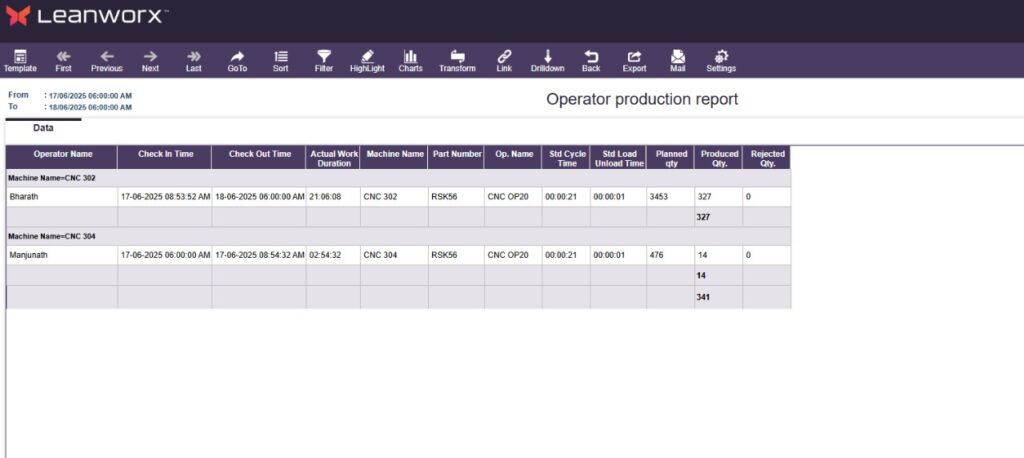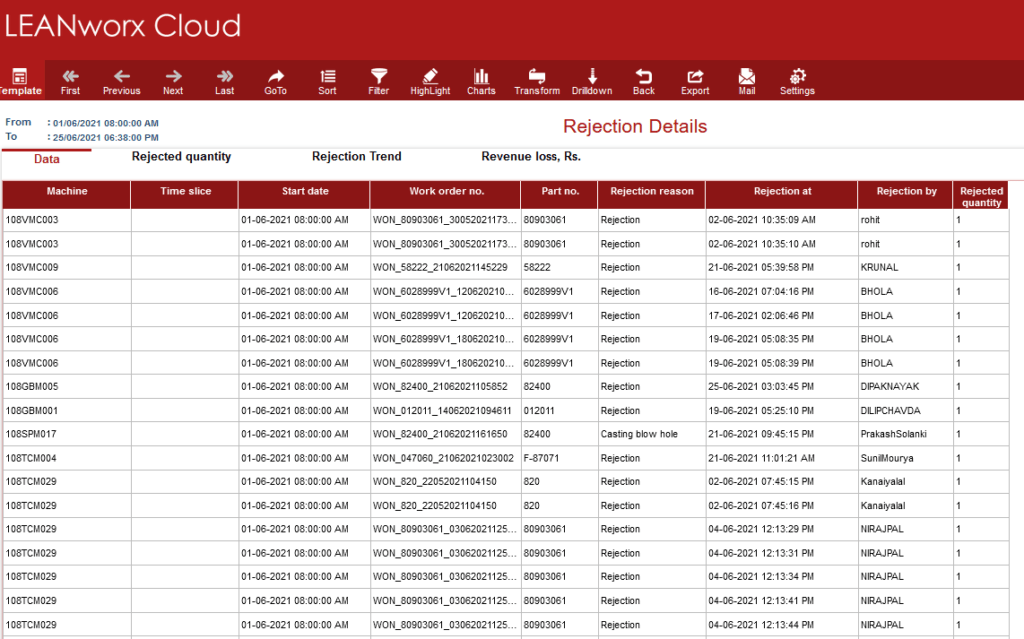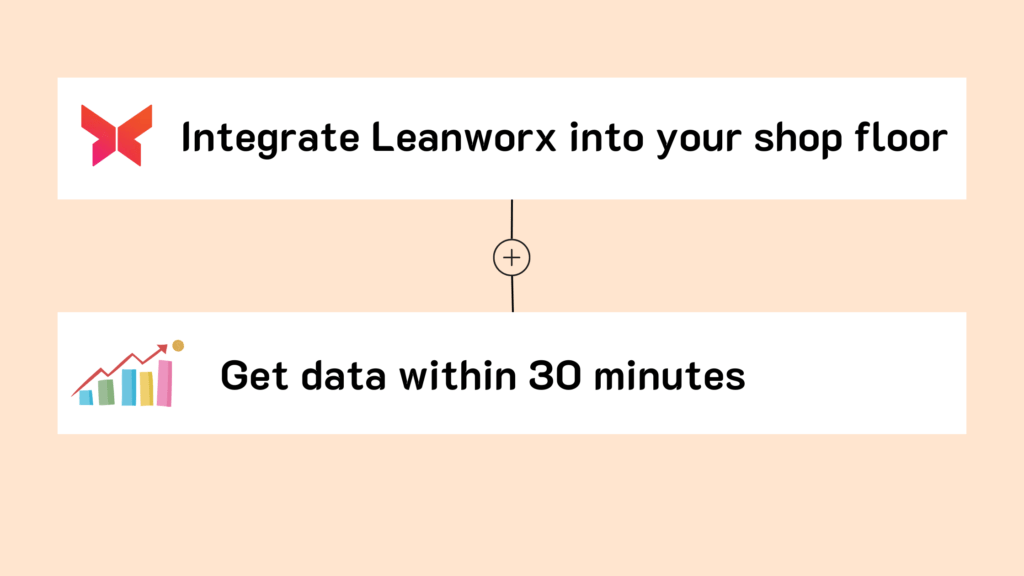Shop floor data collection : What It is & How It Works
- Aug 2, 2024
Category : Production monitoring systems
- Shop floor data collection : What It is & How It Works

Dasarathi G V
Director in Leanworx
Dasarathi has extensive experience in CNC programming, tooling, and managing shop floors. His expertise extends to the architecture, testing, and support of CAD/CAM, DNC, and Industry 4.0 systems.
Try Leanworx for free
Shop floor data collection
What is shop floor data collection, and why is it even required ?
This is the core of the requirement:
- In a manufacturing firm, money is made by machines
- To run profitably, production and quality must be maximized and cost minimized
- To do this, decision makers in the shop floor must get accurate data on production quantity, downtimes and rejections.
- Decision makers are anyone from shop supervisors to the CEO.


Decision makers need to know these, to be able to manage machines efficiently:
- What is the production quantity on each machine at any time ?
- Are machines producing at the planned production rate ?
- What are the downtime incidences and durations ?
- What are the main causes of downtime ?
- What is the percentage of rejections ?
- What are the main causes of rejections ? Raw material, process, machines, operator ?
- Is there any event on a machine that needs immediate attention, like a breakdown ?
What you’ll Learn :
Some examples of improper data or delayed data from machines:
- A part with a tight delivery schedule is running on a machine. There is a machine breakdown for some hours, and production stops. The Manager does not know about this, so does not take any action like shifting the part to another machine. This results in delayed delivery and loss of reputation.
- The rejection rate is very high because of wrong process or tooling, and nobody realizes this till the next day. The whole day’s production is a total loss, not usable.
- In firms that use an ERP system, very often, today’s production is available in the ERP system after one or two days. Documents for sale (invoice and transport) can only be made after this time. The parts produced are in finished goods inventory, and the firm is losing interest on the money that it could have earned.
In firms that use an ERP system, very often, the production quantity is wrongly entered in the ERP system. There is a mismatch between the actual quantity and the one entered in the system.
Shop floor data collection techniques
Shop floor data collection techniques are of 2 categories:
- Manual data collection, paper-based.
- Real-time data collection, electronically.
Manual shop floor data collection

This is how manual data collection works. There are people who go to each machine at the end of every shift, and note down production, rejection and downtime data in a register.
The data is obtained from the machine operator. They then enter them in a computer in the company’s network. Yesterday’s data only gets entered by this morning, since yesterday’s night shift ended this morning.
This data is then used by someone else to make tabular reports and graphs for viewing by various levels of management. The reports are used in the morning production meeting, to review yesterday’s production.
The data is coming to decision makers via a chain of humans, usually cooked up along the way, after 24 hours. So it is inaccurate, and too late to do anything if something requires immediate attention.
Real time shop floor data collection

This is how Real time shop floor data collection works:
- There is a machine
- There is a sensor on the machine that collects data from it
- The sensor sends the data to the internet
- Cloud software collects the data and analyzes it
- Data is displayed to people, sent to other software, sent back to the same machine, or to other machines.
The data is collected automatically, analyzed immediately by software, and available as reports within seconds.
You also get alerts on your mobile phone or email when something happens that requires immediate attention. With production monitoring via an Industry 4.0 based machine monitoring system, data flow is instantaneous, accurate, 24/7.
So here is what an Industry 4.0 based production monitoring system does for you:
With Industry 4.0, instant, accurate data is direct from machines.
With the traditional paper method, inaccurate data after 24 hours.
Reports in shop floor data collection software
You can see a variety of online dashboards and reports with a shop floor data collection software that is part of a real time shop floor data collection system. You can get reports and alerts
- Production monitoring
- Downtime monitoring
- Productivity (OEE) monitoring
- Quality monitoring
- Energy monitoring
- Consumables usage monitoring
- Maintenance monitoring
- Operator efficiency monitoring
Production quantity collection and reporting
Production quantity is available as a variety of reports: hourly production, shift-wise and day-wise production, details of individual cycle times, planned vs. actual production, production quantity trends. Andon boards show the current production quantity, target quantity, downtime, etc.
Start using Leanworx for free
We provide a 5-day free demo, with assistance in installation and usage.
OEE monitoring and reporting
Leanworx has a variety of OEE reports based on data from real time data collection:
- Dashboards showing the current shift OEE, production, downtime
- Andon board large LED displays on the shop floor showing the shift OEE, production, downtime.
- OEE reports shift-wise, day-wise, week-wise, etc., with Availability, Performance and Quality, and the breakup of the calculation for arriving at the values.

- Long term OEE trends monthwise, quarter-wise etc.
- Comparison of OEE between multiple machines and collection of machines – cell, shop, plant.
Downtime monitoring
Leanworx’s machine downtime monitoring feature automatically detects machine downtime durations.
There are a variety of reports : start and end time of each machine downtime incidence with duration and reason, machine downtime analysis reports downtimes at shift change, and long term machine downtime trends.
Quality monitoring
Leanworx can track part dimensions values and rejections. Rejection quantities and reasons can be tracked automatically from signals from the machine or inspection devices, or from operator inputs.
You get reports of rejection details (with every rejection instance), dimension data, analysis of key rejection reasons, and long term rejection trends.
Energy consumption monitoring
Leanworx tracks and reports machine-wise and part-wise energy consumption. It shows reports hourly, daily, weekly, etc. It also shows long term trends of consumption.
Consumables monitoring - continuous and discrete consumables
Leanworx can track and report consumables consumption. It shows reports like these:
- of change, quantity changed, who changed it, etc.
- Consumables usage analysis that shows the consumption of each consumable or type of consumable as Pareto and pie charts. This enables you to focus on the big consumption items and reduce their usage.
Discrete consumables usage:
Tools and inserts on CNC machines, coolant usage, lube oil, etc.
Continuous flow consumables usage:
Energy consumption (kWh), LPG or inert gas in furnaces, inert gas consumption in welding, welding wire consumption in welding robots, etc.
HR data tracking and reporting
Leanworx tracks and reports the performance of individual operators, with features like these:
– Matching of machine with operator skill level
– Rejections and consumables consumption by each operator
– Shift-wise operator efficiency details
The reports can be used in the following ways to improve productivity and reduce operator attrition:
– Identify skill gaps and provide training to fix the gaps.
– Pay incentives based on individual performance
Maintenance monitoring
Leanworx has maintenance features that can dramatically improve efficiency of your maintenance, reduce machine downtime and cut cost of spares.
It has a variety of features for scheduling, tracking, alerting and reporting for various types of maintenance:
- Unscheduled maintenance or breakdown maintenance (UM): Automatic ticket creation, opening, closing, acceptance.
- Time based preventive maintenance (TBM): scheduling, automatic ticket creation, alerting
- Usage based preventive maintenance (UBM): automatic ticket creation, alerting
- Condition based maintenance (CBM): automatic ticket creation, alerting
- Tracking of MTTA, MTTR, MTBF
Alerts in shop floor data collection software
You can get instant alerts on your mobile phone or email that enable you to take immediate action in response to serious issues on the shop floor like : machine breakdown, abnormal downtime, production quantity below target, abnormal rejections, operator absence, etc.

Each set of decision makers get different alerts. E.g., Production supervisors and managers get an alert on their mobile phone or email when there is a target shortfall in a shift. Alerts also have an escalation logic if problems are not fixed on time.
Keep Learning
Increase your profits automatically. Use Leanworx to get accurate and instant data 24/7.





